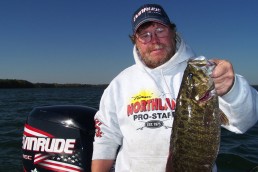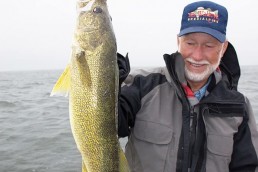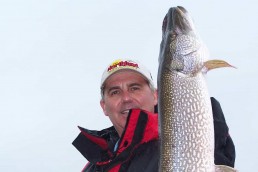Think you Understand Pike and Their Impact on Other Fish?
SHARE THIS POST
Talk to almost any angler who catches a northern pike while fishing for walleye, lake trout, yellow perch, black crappie or bass and they’ll tell you to carefully wash your hands and lure in soapy water to remove the negative scent of the big toothy predator.
Jeff Matity isn’t your typical angler.
“If I could bottle the stuff I would,” says Matity, who is the biologist in charge of Saskatchewan’s Fort Qu’Appelle Fish Hatchery. In fact, are you ready for this? Matity says he favors tipping his jigs and spoons with a thin strip of pike meat that he carefully carves from the belly of a small fish that he has eaten at shore lunch.
I know what you’re thinking—what about all the noise we’ve heard for years about the scent of pike deterring fish from biting?
“The planet would be overrun with pike,” Matity chuckles, “if it wasn’t for the fact that everything loves to eat them. Fish never become conditioned or turned off to the flavor of pike. If a walleye, perch or bass is eating pike fry and fingerlings from the time they’re five or six inches long, why wouldn’t they keep eating them forever?”
But doesn’t a big pike cruising along the edge of a weedline put other fish on guard?
“When a big pike is moving around, flexing his jaws and giving everybody the evil eye,” says Matity, “yeah, that is when the hair goes up on the backs of their necks and they probably hunker down.
“But I’ve studied them in the aquarium at the Fish Behavioral Lab at the University of Saskatchewan and there are many times when the fathead minnows are lying right beside the pike. When the pike are laying on the bottom, in a non-assuming position, just sitting there breathing, probably dreaming, the minnows are lying beside them and eating. But when that same pike wakes up and starts cruising the mid-depth, flexing his jaws, the minnows go on alert.”
So, it is as much or more of a visual clue, I suggest to Matity, as it is a scent related one.
“As soon as that northern pike eats any of the minnows,” Matity says, “he breaks the alarm system cells on the mucus layer. He doesn’t even have to break the skin or remove a scale and every minnow in the tank knows that something is going down.
“And as soon as that pike digests the minnow, he does his best to go to the very far corner of the aquarium to defecate. In the wild, he doesn’t defecate in the area where he hunts. It is called localized defecation. It is proven. It is science.”
“In the spring, you can go into a bay and see pike (and muskie) poop everywhere. The pike aren’t in these super shallow bays because they’re eating. They’re in the bays because they’re digesting. So, they’re going out into ten feet of water off the main lake point to eat ciscoes, burbot and whatever else, and then they’re coming back into the shallows to digest.”
Listening to Matity talk about the elaborate relationship between northern pike and their prey, and in the process quashing so many myths about the big toothy critters is so fascinating I hardly know what to ask him next. I settle on the unique odor that you can smell when you catch a pike. Can’t the walleye, trout, perch and bass identify it as well?
“Sure they can,” he says. “The minnows know that that thing coming towards them smells like it has been eating minnows, but its non-assuming and it is not a threat. We know that pike are ambush predators, although at any given time they might jump you, so they have to be giving off that S-curve. There is an awful lot of body language going on that the other fish—the prey—have learned to identify.”
Which brings us to a hitherto secret that Matity, who is a renown big fish specialist, really doesn’t want to tell me about. It is the fact he loves tipping his lures with a strip of meat that he slices from the belly of a pike. He not only doesn’t believe the odor deters or scares away walleye, trout, perch or bass, he believes it attracts and triggers them to bite.
Are you enjoying this post?
You can be among the first to get the latest info on where to go, what to use and how to use it!
“Remember,” he says, “the strip I use is only about the size of your ring finger. So, to put it into anthropomorphic terms, a walleye, perch or lake trout smells it and thinks, “that little rotten bugger has been eating my kin, but he is small enough for me to eat him.”
“A 10- or 12-inch perch or big walleye isn’t intimidated by a finger-size pike that is giving off blood and body fluids and looking injured on the end of a jig. My brother Jason and I have caught some of our biggest walleyes along the deep edge of cabbage beds using pike belly strips for bait. We’ve had many 100 walleye and perch days here on the Qu’Appelle system tipping our jigs with pike belly. We use it, too, when we jig in deep water for lake trout.”
Evolutionary arms race
“If anglers ever studied the evolutionary arms race between predator and prey,” Matity chuckles, “they would see that it is flipped in favor of the prey. The beauty about a small 4-, 5- or 6-inch pike is that it is no different than a ciscoe. It is soft-skinned, high protein and goes down a walleye’s throat easier than a ciscoe. It is a beautiful meal.
“In addition, yellow perch would be at a huge disadvantage if they didn’t take the opportunity to eat as many small pike as they could. Especially, when the small pike are sharing the same weedy habitat.
“It is the way the evolutionary arms race works. I am a perch and I am going to eat pike for my whole life. And do you know what? I am probably going to get eaten by a pike one day. That is just the way it works, man. Those pike don’t live down there for free. Can you imagine a walleye cruising along the edge of a weedbed and seeing this little green thing. It moves in on it, gets a little closer and then, whoops it’s gone. That is how it goes in the fish world.”
What I find particularly intriguing listening to Matity talk about the predator-prey arms race, and I quickly mention it to him, is the fact that the number one fish that I have found over the years, sticking out the throat of a big pike that I’ve just caught is another smaller northern pike.
“There is huge risk for any species in cannibalism,” Matity tells me, “because it is a direct and very dangerous vector of disease. If people ate other people, and you ate someone with tuberculosis, you’re probably going to get it.
“When it comes to the biggest fish, however, it has survived this risky behavior for its entire life. So, it has been exposed to every single vector of disease through cannibalism and survived.
“So it is immune.
“What this means, then, is that once a pike gets into the 20-pound class, it can convert the tissue from conspecifics so much more efficiently. So the big pike can covert other pike flesh better than eating suckers, lake trout, ciscoes, walleyes, yellow perch or anything else. Once its body pulls apart the flesh, the protein building blocks just fit. So it is better when you’re a big pike to be a cannibal. They do beautifully once they’re cannibals. Oh, and by the way, the very same principle applies to lake trout, walleyes and just about every other species of fish. Mother Nature is brilliant. God is good, but Mother Nature is brilliant.”
If you get the feeling that Matity is passionate and enchanted by big northern pike, you’re right. The science intrigues him and he is forever looking for ways to use it to help him catch big fish.
“Pike are environmental chameleons,” says Matity. “I think they’re the most successful freshwater game fish on the planet. They have a shallow water lifestyle until they mature. Then they split their time between shallow and deep water habitats. When they become King Kongs, if the environment and food chain is perfect enough to produce a 20- or 30-pound pike, they’re basically just like lake trout, but with the ability to go shallow to feed. I don’t think a lake trout could spend 20 minutes in 70 F water without freaking out.
“Pike pay their dues like everybody else when they’re small. Dyticus water beetles probably wipe out more of them than anything. Then they graduate to being food for fathead minnows, yellow perch and walleyes. That 30-pound pike has paid her dues. She doesn’t deserve to get whacked on the head.
“When you see a little 4- to 6-inch long pike swimming around the boat launch , sitting in the weeds, just below the surface, it is an easy target. It doesn’t have a friggin’ prayer if there is a bigger fish looking up at it. But we need a lean population of pike in order to get big ones. If we have an over abundance of pike, we end up with a stunted population. So it’s good that everything eats them. Mother Nature is willing to give up 99.97 percent of them in any given year, so long as the big mature fish are there. The life of a pike is a double edged sword and it swings both ways.”
Amen, brother Matity, amen.
MWO
SHARE THIS POST
Did you enjoy this post?
You can be among the first to get the latest info on where to go, what to use and how to use it!
Gord Pyzer
Hall of Fame fisherman, fisheries scientist, and legendary fishing writer Gord Pyzer has a Master’s in Resource Management, spent 30-plus years with Ontario Ministry of Natural Resources, and is a pioneer in modern muskie management. Pyzer is Fishing Editor for Outdoor Canada magazine, and now a regular contributor to MidWest Outdoors.



